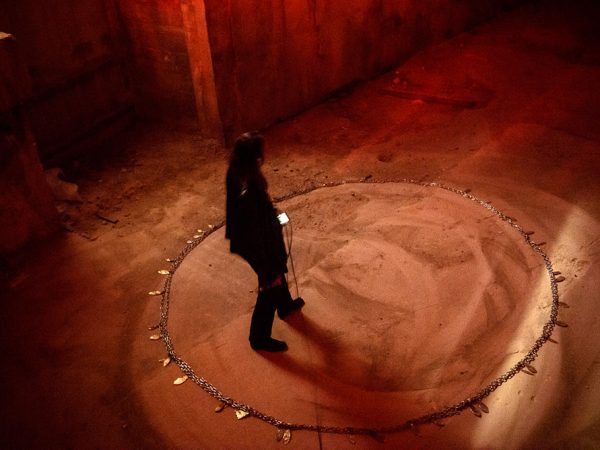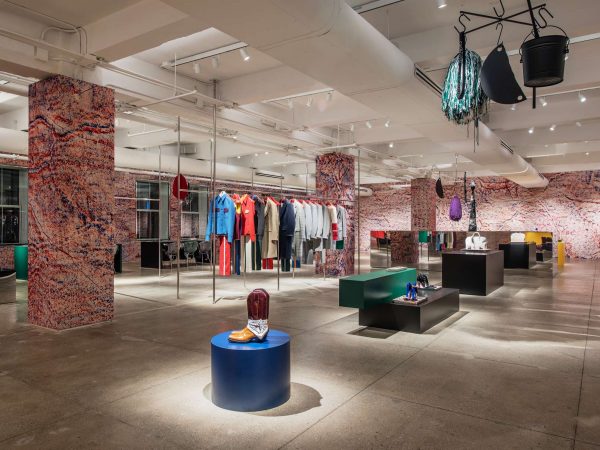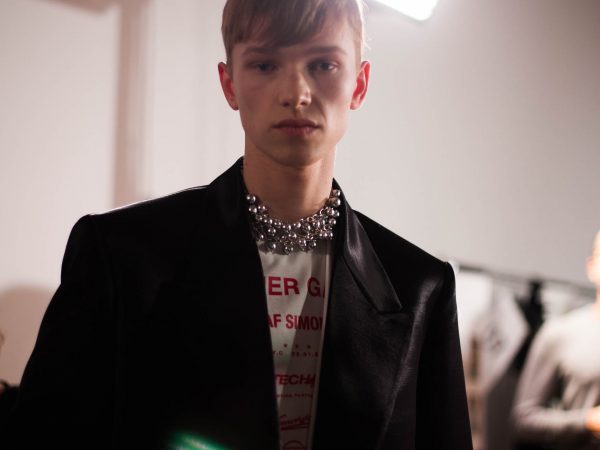Hood by Air designer Shayne Oliver has had a banner year. After showing for the first time in Paris high above the city in the Montparnasse Tower this past fall, Oliver has set his sights on turning HBA into a growing movement. He was invited to show at Pitti Uomo, Florence’s prestigious menswear show, and has immersed HBA fully into Italian fashion, recently opening design studios in Milan in order to take advantage of Italian manufacturing. Oliver sits down with the acclaimed mixed media artist Rashaad Newsome, who has in recent years shown performances and works at The Whitney, The New Museum, and MoMA/PS1, to discuss Italian fashion, prisoners, and why you shouldn’t call Oliver a streetwear designer.
Rashaad NEWSOME—Hood by Air has always been in dialogue with street culture, specifically New York street culture. How has it been relocating your practice to Milan? Do you find that your work is influenced by street culture there?
Shayne OLIVER—Subconsciously yes, but I feel like I’m more inspired by the longing to be home, or things that remind be of being at home. I’ve integrated myself within their culture, so I haven’t been influenced by them yet, it’s just more about utilizing Milan fashion’s resources, and the longing to be home—of putting those memories that I have of New York into what I’m actually doing while I’m in Milan.
Above The Fold

Sam Contis Studies Male Seclusion

Slava Mogutin: “I Transgress, Therefore I Am”

The Present Past: Backstage New York Fashion Week Men’s Spring/Summer 2018

Pierre Bergé Has Died At 86

Falls the Shadow: Maria Grazia Chiuri Designs for Works & Process

An Olfactory Memory Inspires Jason Wu’s First Fragrance

Brave New Wonders: A Preview of the Inaugural Edition of “Close”

Georgia Hilmer’s Fashion Month, Part One

Modelogue: Georgia Hilmer’s Fashion Month, Part Two

Surf League by Thom Browne

Nick Hornby: Grand Narratives and Little Anecdotes

The New Helmut

Designer Turned Artist Jean-Charles de Castelbajac is the Pope of Pop

Splendid Reverie: Backstage Paris Haute Couture Fall/Winter 2017

Tom Burr Cultivates Space at Marcel Breuer’s Pirelli Tire Building

Ludovic de Saint Sernin Debuts Eponymous Collection in Paris

Peaceful Sedition: Backstage Paris Fashion Week Men’s Spring/Summer 2018

Ephemeral Relief: Backstage Milan Fashion Week Men’s Spring/Summer 2018

Olivier Saillard Challenges the Concept of a Museum

“Not Yours”: A New Film by Document and Diane Russo

Introducing: Kozaburo, 2017 LVMH Prize Finalist

Introducing: Marine Serre, 2017 LVMH Prize Finalist

Conscious Skin

Escapism Revived: Backstage London Fashion Week Men’s Spring/Summer 2018

Introducing: Cecilie Bahnsen, 2017 LVMH Prize Finalist

Introducing: Ambush, 2017 LVMH Prize Finalist

New Artifacts

Introducing: Nabil Nayal, 2017 LVMH Prize Finalist

Bringing the House Down

Introducing: Molly Goddard, 2017 LVMH Prize Finalist

Introducing: Atlein, 2017 LVMH Prize Finalist

Introducing: Jahnkoy, 2017 LVMH Prize Finalist

LVMH’s Final Eight

Escaping Reality: A Tour Through the 57th Venice Biennale with Patrik Ervell

Adorned and Subverted: Backstage MB Fashion Week Tbilisi Autumn/Winter 2017

The Geometry of Sound

Klaus Biesenbach Uncovers Papo Colo’s Artistic Legacy in Puerto Rico’s Rainforest

Westward Bound: Backstage Dior Resort 2018

Artist Francesco Vezzoli Uncovers the Radical Images of Lisetta Carmi with MoMA’s Roxana Marcoci

A Weekend in Berlin

Centered Rhyme by Elaine Lustig Cohen and Hermès

How to Proceed: “fashion after Fashion”

Robin Broadbent’s Inanimate Portraits

“Speak Easy”

Revelations of Truth

Re-Realizing the American Dream

Tomihiro Kono’s Hair Sculpting Process

The Art of Craft in the 21st Century

Strength and Rebellion: Backstage Seoul Fashion Week Autumn/Winter 2017

Decorative Growth

The Faces of London

Document Turns Five

Synthesized Chaos: “Scholomance” by Nico Vascellari

A Whole New World for Janette Beckman

New Ceremony: Backstage Paris Fashion Week Autumn/Winter 2017

New Perspectives on an American Classic

Realized Attraction: Backstage Milan Fashion Week Autumn/Winter 2017

Dematerialization: “Escape Attempts” at Shulamit Nazarian

“XOXO” by Jesse Mockrin

Brilliant Light: Backstage London Fashion Week Autumn/Winter 2017

The Form Challenged: Backstage New York Fashion Week Autumn/Winter 2017

Art for Tomorrow: Istanbul’74 Crafts Postcards for Project Lift

Inspiration & Progress

Paskal’s Theory of Design

On the Road

In Taiwan, American Designer Daniel DuGoff Finds Revelation

The Kit To Fixing Fashion

The Game Has Changed: Backstage New York Fashion Week Men’s Autumn/Winter 2017

Class is in Session: Andres Serrano at The School

Forma Originale: Burberry Previews February 2017

“Theoria”

Wearing Wanderlust: Waris Ahluwalia x The Kooples

Approaching Splendor: Backstage Paris Haute Couture Spring/Summer 2017

In Florence, History Returns Onstage

An Island Aesthetic: Loewe Travels to Ibiza

Wilfried Lantoine Takes His Collection to the Dancefloor

A Return To Form: Backstage New York Fashion Week Spring/Summer 2018

20 Years of Jeremy Scott

Offline in Cuba

Distortion of the Everyday at Faustine Steinmetz

Archetypes Redefined: Backstage London Fashion Week Spring/Summer 2018

Spring/Summer 2018 Through the Lens of Designer Erdem Moralıoğlu

A Week of Icons: Backstage Milan Fashion Week Spring/Summer 2018

Toasting the New Edition of Document

Embodying Rick Owens

Prada Channels the Wonder Women Illustrators of the 1940s

Andre Walker’s Collection 30 Years in the Making

Fallen From Grace, An Exclusive Look at Item Idem’s “NUII”

Breaking the System: Backstage Paris Fashion Week Men’s Autumn/Winter 2017

A Modern Manufactory at Mykita Studio

A Wanted Gleam: Backstage Milan Fashion Week Men’s Autumn/Winter 2017

Fashion’s Next, Cottweiler and Gabriela Hearst Take International Woolmark Prize

Beauty in Disorder: Backstage London Fashion Week Men’s Autumn/Winter 2017

“Dior by Mats Gustafson”

Prada’s Power

George Michael’s Epochal Supermodel Lip Sync

The Search for the Spirit of Miss General Idea

A Trace of the Real

Wear and Sniff

Underwater, Doug Aitken Returns to the Real
Rashaad—Do you find some of the American aesthetics of streetwear heavily at play there?
Shayne—I think so, yes. I think they have a really misinterpreted rendition of what Americana is about. Usually, a lot of times we have to force them or re-explain, or teach them, literally, what it really is about. “Oh, yeah. A t-shirt.” It’s like, yes, but that’s like a horrible t-shirt, in order for it to be a great one, you have to do “this, this, and that”. Some things that aren’t so normal to us are almost like couture to them. They’re like, “Really? That’s really how you see and do that?” So, it’s been that. I’ve been teaching them American philosophy of fashion.
“It’s a play on how sometimes the person who looks really scary is actually not, that they embrace an overabundance of threats to seem like they’re not scared themselves.” —Shayne Oliver
Rashaad—Do you think that’s because there’s a huge divide between couture and street wear? It’s something that’s everyday. So the concept of making things like t-shirts, jeans, or sweats couture—they don’t look at those objects as having an ability to communicate that?
Shayne—No. For instance, like luxury, I have a fucked up view with it, and that’s sort of what it is to them. They’re like, “No, don’t we look really cool and normal? We look American.” You know, there’s a way of looking like an American that’s right and wrong.
Rashaad—What are some of your inspirations for the next collection?
Shayne—The feeling is about the allure of fear and how people tend to begin a conversation of respect with something that will make someone afraid ofthem. I was building off of guys like inmates, pimps, politicians—all these guys that still scare people or keep people in check. That’s what the New York (F/W 2015), season’s collection is based off of.
Rashaad—I’m sure you’re aware with all the heinous acts that happened recently against black men living in New York City and how they perpetuate the stereotype of the menacing male figure. Are you going to play with that?
Shayne—It’s a play on how sometimes the person who looks really scary is actually not a threat, the theory of someone who is just using threats because they’re not, and they use an overabundance of threats to hold their ground and seem like they’re not scared themselves.
Rashaad—Performance and video has always been a part of your repertoire and I’m always excited tosee how you incorporate that into your show. Will we see some of that?
Shayne—This season, less so. I just did Pitti [Uomo] this season, I feel like right now this season has not left me calm and comfortable. It’s much more of a comfort thing, it feels very grounded and I don’t feel very extroverted. I don’t feel like pushing out what’s on my mind. I’m more so content with making someone look really good this season. I think that a lot of what’s happening has to do more with the wardrobe of the person than actually showing everyone what’s going on the mind of the person. It’s sort of respecting them based upon the fact of how they dress opposed to respecting them by the way they think. It’s going to be performative in a sense of the personality of the models themselves. Other than that, it’s a very internal confidence for the theme this season.
Rashaad—So I feel like, to bridge on the whole idea of confidence I want to talk a little bit about the idea of vogue, as it was a big part of the show before the last one. In the past two years we’ve seen balls, become increasingly referenced in art and fashion. Why do you think that is?
Shayne—The idea of the black gay man right now is one of the only punk things. I think that fashion always tends to move towards the energy of something that is given a voice, or embodies punk. I’m saying punk because that’s what people associate that energy with. It’s one of the only that hasn’t been talked about or had a voice before. I think fashion grasps onto that beacsue its creating a voice and a new energy that hasn’t been explored. It’s an appreciation but also a feeling of the ideas that people thought they knew or referenced. And now, it’s allowed to be referenced more. People are grabbing onto it because these are things that they’ve probably been talking about or feeling for a while. That it’s never been in style is because a certain few people have done that. People feel more open to go to the references that they’ve always admired, have always been into, but were always taboo.
Rashaad—The fashion world has grown increasingly more accepting of gender fluidity. Why do you think that’s happening now?
Shayne—I think because the people that have the most style right now and understand fashion in the best way possible are fluid about how they dress. I don’t think it’s anything political or has anything to do with wanting to be a boy or girl. And that idea makes the most sense for the world we live in. It’s the backlash of people refusing to be told how to dress. Like when women only wore suits because they were never allowed to, or the idea that guys that are
in fashion were always getting in drag. That to me is behind the scenes, which has always influenced what’s in the front. Now it’s become so normal.
Rashaad—Do you think this moment is going to last?
Shayne—I think it’s a direction that’s modern. I don’t know how to describe it other than that. It references now. And it’s been the only thing that I think is fresh. You can wear a heel and sweats, whether you’re a boy or a girl. That is actually modern. It’s not kitschy—it is something that is fresh in the world right now. I don’t know if it’s a fad. I know that it feels right. I think that everything that was a fad becomes an institution in fashion anyways. Look at grunge; it was a fad and now it’s every last designer from the high-end to low-end. People see things that are modern and they would never think of doing, because it’s not obeying.
Rashaad—We’re experiencing a time where there are more African-American designers than ever, but there are very few today at your age and level. I wanted you to speak about your experience. What are some of the obstacles you’ve faced?
Shayne—What I will say is that, for me, I have personal moments where I have to take a breather because I never actually think about the obstacles. I can either ignore everything, or I can read into everything online, so I’d rather not read into anything at all and keep it moving and just see it as part of what I have to do in order to get what I need to get done. Racism is funny. It’s silly to me, so I don’t really take it seriously. That’s partially why it never has gotten in my way, because I never took it to be something like, “Oh my god, this person is racist.” I’m not going to let that affect me. I’m going to be like, “Oh, you’re racist. You’re really silly.” It’s more laughable, I’m like, “I can’t even take you seriously, right now.” One thing that bothers me is that when people say I’m street fashion, when I’m a designer influenced by the street. I’m influenced by where I grew up, but I think that’s a legitimate fashion expression, that’s the only thing that I will say is an outward frustration.
Rashaad—To give people a little insight, what are some musicians are you listening to right now? Who are some designers that you find inspiring? What are some artists?
Shayne—I like kids that keep it moving. I like Alexander Wang, when he does Wang. I like Ed Marler, Craig Green, Pedro Lourenço.
Rashaad—I see a lot of cross-brand collaborations now, more than ever. Is that something that we’re going to see from Hood By Air?
Shayne—Yes. It’s something I want to do and that’s something we’re looking into more after this season. I don’t have anything in the works right now. We’ve been focusing so much on getting our structure together and we thought it was an incubation period for us to know what we want and know how to get it. Now, we’re at a place where we can expand and begin to collaborate and be more open. We never wanted to feel locked off, we wanted to get our
shit together first before expanding with other people.
“I think because the people that have the most style right now and understand fashion in the best way possible, are fluid about how they dress. I don’t think it’s anything political or has anything to do with wanting to be a boy or girl. And that idea makes the most sense for the world we live in.” —Shayne Oliver
Nick Vogelson—There’s a recent article in New York Magazine with a quote from Leilah [Weinbraub, Hood By Air’s CEO], where she mentions you learned everything important at nightclubs and everything is perfect at night. There are similarities in both of your work that comes out of nightclubs.
Rashaad—In terms of my work what comes out of nightclubs, when I first started to make work dealing with vogue, some of my early experiments, I was playing with the framing of vogueing in the original way you experience when you go to a ball or a club you have the performer performing, but then you also have somebody over here doing something, and somebody over here doing something, so the staging and the experience of being is very much different from minimalism and I think as I started to make that work I realized how important it was to hone in on the dance, that would be how I engage the nightclub.
Shayne—For me, you go out [to a nightclub] to serve and to push buttons and to experiment and to make your daytime experience better so at night night you’re trying new things out. It’s a laboratory for me, like, “Let me play with this look and how it feels.” A lot of looks that I’ll pull into Hood By Air are things that you would try out at night, because it’s a caliber that had to be met. We would experiment with that, and if you like the look a lot or get a great response you carry that look on into the day and then it becomes your look as a person. That’s why it’s so important, because these ideas are—you go to let loose and also push yourself as a person. The music needs to be louder, you need to get higher, you need to sweat more, you need to dress better. It’s always something where you’re pushing. It’s always pushing. That’s why it was so important for me to be there in the crowd, because its also the friendships, it has to do with why it’s so important.
Rashaad—I like that. I think it really comes through because it’s sort of the way you’re feeling it in the club. It makes me think about how so many rappers would make music to play in the club to see how people would respond to it and that’s the true test of its validity and how you’re doing that with fashion.
Shayne—I started working on Hood By Air when I started to calm down and not really go off and dress up anymore. It became such a habit that I would be wearing the next collection every single time I went out. I would be like, “This bitch is looking at my look. I can’t do this anymore.” Then you start realizing, “Oh, this is really important.” That’s when the importance of it was evident.























